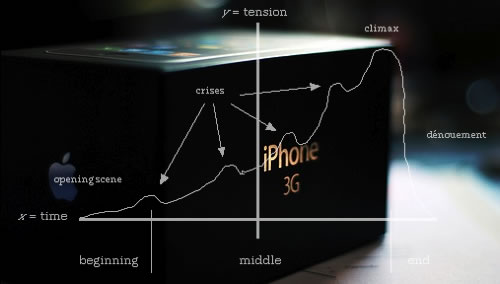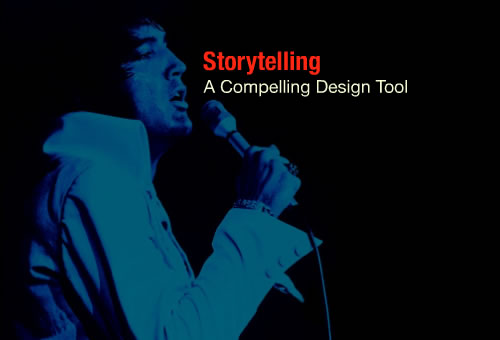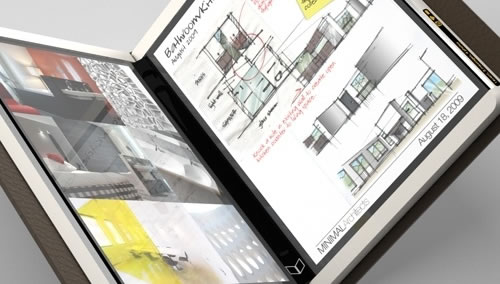Better User Experience With Storytelling (Part 2)
In the first part of this Better User Experience With Storytelling series, we explored some of the basic structures and story patterns found in myths and religions. We saw how these patterns continued into modern stories such as The Matrix and Star Wars. We also explored some of the basics of bringing storytelling into the user experience process and some places to get started.
Concluding this two-part article, we hear from creative professionals who are leading the way in this relatively new world of combining the craft of storytelling with user experience. We’ll also see how storytelling can be applied to more than just interactive experiences: we find it in everything from packaging to architecture.
A Few Modern-Day Storytellers
Although the idea of using storytelling within the user experience process is fairly new, a few professionals are using it in their projects. I spoke with some of these modern-day storytellers to get their perspective and see how they are applying storytelling to their work.
Dorelle Rabinowitz
Dorelle is a storyteller who designs, illustrates and tells stories in a variety of media and contexts. Mostly she tells stories.
Question: How do you approach storytelling in UX?
Dorelle: I see it as another tool we can use as a catalyst for communicating during our design activities. For me as a designer, it’s about putting a human face on the design process and bringing people together. You can get designers, engineers, product managers, strategists and execs jazzed about a proposed feature because of a story, and it can be extremely fulfilling. As a person, it’s all about the emotional connection.
Back in the day, I’d worked on an Oxygen media site called “Our Stories,” where we created short online digital stories with our audience. We called it co-creation, and when I moved more into designing user experiences I realized that stories helped me understand my users better. As I did more and more work, I realized that storytelling facilitates communication, that people respond emotionally to stories, bond over stories and share stories again and again, and that the more I integrated storytelling into my work the better the work was.
So much of what we do isn’t only about the design but about how we deal with people, negotiate and plan. Storytelling can be effective in all of these situations as well as in driving towards our solutions. I think the value of using stories is independent of the type of experience.
Question: In the end, business goals (i.e. profit) rules the day. How does storytelling tie into this?
Dorelle: Stories help bridge understanding, so storytelling can help teams get on the same page and speak the same language—leading to expected results. Stories can help people work more collaboratively and thus help teams get it done faster—faster time to market. Stories can help reframe business problems so that projects solve the right problems and come to a better solution.
Question: Where is the best place to learn more?
Dorelle: Cindy Chastain’s article in Boxes and Arrows on Experience Themes is a great read.
Curt Cloninger
Curt is an artist and writer. He says his art doesn’t really tell a standard narrative with a climax and resolution but rather tries to create a kind of event experience.
Question: How do you approach storytelling in UX?
Curt: Design, particularly graphic design, can be understood as a visual form of communication, and storytelling is a historically tested form of communication. Storytelling or narrative design is more like something to keep in mind when considering the user’s experience.
To me, narrative design just means having a consistent “voice” and having every design element contributing to the same goal or conclusion. It also means allowing for an arc in the user experience. And it means allowing the user to have some kind of personal say in completing her experience. This is the difference between a novel (where the user mentally fills in lots of visual blanks) and a Hollywood action film (where all the blanks are filled in for the user). A novel is arguably more engaging.
Question: In the end, business goals (i.e. profit) rules the day. How does storytelling tie into this?
Curt: Hollywood tells stories, and they seem to make a lot of money. Politicians, journalists and large corporations often tell stories (i.e. lies), and they make money. The evolution of any brand over time is a kind of narrative. Corporations spend all sorts of money trying to convince us that their main character (Ronald McDonald) is the good guy. Narrative and capitalism have always enjoyed a fruitful relationship.
Question: Where is the best place to learn more?
Curt: I like Nathan Shedroff’s Experience Design book. It’s more about “XD” than “UX,” but it addresses narrative at several points throughout. Richard Schechner’s Performance Theory is good. It has nothing to do with user experience design per se, but it is about theater, tribal ritual and the cultural interfaces that people construct to give meaning to their worlds.
Christian Saylor
Christian is a storyteller who designs user experiences. He believes that the things around us have very powerful stories to tell.

Question: How do you approach storytelling in UX?
Christian: Storytelling gives us purpose and a sense of place. So, it hasn’t been so much a “discovery” of storytelling as a natural progression towards uncovering an experience buried deep within a narrative that wants to be told. So this idea of adopting “storytelling” as a means to uncover a rich experience for the “end” user, whoever they may be, just makes sense.
At the end of the day, the job of the (UX) designer is to help tell a story that is relevant and meaningful, regardless of time, device or even location. We use “personas” (characters in our story) and “scenarios” (narratives that tell a story about the persona) in order to fully understand not only the target audience but also their goals and desires, which will ultimately help to create a meaningful experience for them.
I strongly believe that everything has a story associated with it. Every business, social group, concept, methodology and relationship is desperately seeking out better ways to engage with its audience. Some just happen to do it on a large scale (Apple), while others quietly create a pattern of life that goes unnoticed until it disappears (the remote control). From packaging that sits on the store shelf to the applications that follow us throughout our days, story influences just about every aspect of our lives. Story is all around us. It gives us a sense of understanding and knowledge of the people and things that are important to us.
I think the most important aspect of storytelling for me is that it has the ability to change the way we view and interact with our world.
Question: In the end, business goals (i.e. profit) rules the day. How does storytelling tie into this?
Christian: If you’re telling the right story to the wrong audience, or even telling the right story the wrong way, then your business or product will ultimately fade away. Design and technology are the catalysts of change in the “experience economy.” And if we don’t seek out better ways to tell our story, then our business, product or service will be in jeopardy of losing its vitality. And as we all know, the business world is constantly looking at the bottom line. We live in a world saturated by products and services that vie for our attention, and the experience—the way in which a story is unfolded—will be the difference between a company’s success and failure.
Question: Where is the best place to learn more?
Christian: Lovemarks (the future beyond brands) by Saatchi & Saatchi. It has unbelievable insight into the way we fall in love with the companies and products that surround us.
(Disclosure: Both Christian and the author are employees of Universal Mind.)
Cindy Chastain
Cindy is a trained filmmaker and screenwriter. She continues to make films and write scripts and considers herself a visual and dramatic storyteller.
Question: How do you approach storytelling in UX?
Cindy: Storytelling is another discipline that can be used in the context of design as 1) a device, 2) a framework and/or 3) a craft to draw upon. In other words, we can use story as a way to capture and sell an idea; we can use it as a way to frame an approach to the design of a product or service; or we can use narrative techniques to craft an interaction and, hence, a variety of behavioral and emotional responses to a story.
We tell stories that seek to order chaos, provide meaning and engage the emotions of our listeners. We design experiences that hopefully do something similar. But in the context of design, meaning is also about what this experience, product or service will do for a person. It’s about how something fits into or enhances his life. It’s about understanding how something is supposed to function.
As designers we do well at facilitating the dialogue between people and the interactive products they use. But we often neglect to consider the more intangible layer of experience, the stories that evolve dynamically through interactions that people have with the things we make. We also lack an approach to holistic design. If we can learn to approach design more like writers approach stories, we will not only build richer experiences but start to develop a craft in our work that knows how and when certain narrative techniques can be used to engage the minds, emotions and imaginations of users.
Knowing the craft of narrative will help us build better stories, which will help us turn a set of lifeless features and functions into a whole experience that engages the minds and emotions of customers.
Question: In the end, business goals (i.e. profit) rules the day. How does storytelling tie into this?
Cindy: Brand message is no longer the thing that sells. Experience sells. If the intangible pleasure, emotion or meaning we seek can be made tangible through the use of story and narrative techniques, we will build more compelling product experiences. And if the experience is more compelling, businesses will profit from droves of loyal, experience-discerning customers.
Without this understanding, choices about what features should be included and how they should behave seem both uninspired and disconnected. Sure, we have business goals, user needs, design principles and best practices to draw on, but these things won’t get us to a place where a team is collaborating in the same conceptual space, let alone designing for emotion and meaning.
Question: Where is the best place to learn more?
Cindy: Start with the discipline itself, like Story, Robert McKee’s book about screenwriting. For a dive into theory, I recommend Narration in the Fiction Film, by David Bordwell and the classic Computers as Theatre by Brenda Laurel. And for the first word on storytelling read The Poetics by Aristotle.
The Storytelling Experiences Around Us
There are many experiences in which storytelling is used to create a compelling message that draws users in. The stories are not always visible or apparent right away, but underneath many good experiences we can find great stories. They may appear in a series of interactions that tie into a larger story or simply in an emotional connection that we form with a product or brand.
In Packaging: Apple

Image source: Re.Mo and Typical Story Arc.
One company the excels at delivering a powerful story is Apple. Laid over the image of the iPhone box above is the story arc (introduced in part 1) that most screenplays and novels follow. Purchasing an Apple product and opening the many beautiful layers of the packaging follow a similar story arc in building anticipation. As you move through the process, you find compelling photography and clever writing. These build a sort of satisfying tension until you finally arrive at the climax of the experience and uncover the iPhone. A more common anti-climactic approach would be to wrap the iPhone in bubble plastic, reducing the story to a mere “Buy me.”
In Technology: Microsoft Courier
The Microsoft Courier device is in the “late prototype” stage of development. This is more of a booklet than Apple’s iPad, with dual multi-touch screens. This video uses storytelling to take you through the user experience of the booklet. Instead of simply running through some of its cool features, it tells us the compelling story of a project in which the potential of the Courier is exploited.
In Marketing: Six Scents Perfume
The Six Scents range of fragrances is created annually by pairing six prominent artists with six celebrated perfumers. The goal is to help raise awareness for a specific charitable cause. For the second series, each bottle comes with a DVD that contains a film and photography. The film and imagery create a story around each scent to evoke a certain feeling and theme.
In Architecture: HBO Store

The HBO Store (in mid-town Manhattan) is designed with storytelling built seamlessly into an immersive experience. The architecture and technology allow the space to become a new way to experience the props and merchandise for the HBO-based shows. The goal of the store (designed in part by design and branding studio Imaginary Forces) was to create an intelligent and memorable experience for visitors.
In Data: Taxi07:Roads Forward
In her comments on storytelling, Dorelle Rabinowitz shows how storytelling can be used to communicate otherwise boring data and turn it into a more accessible experience. One example of this was Taxi07:Roads Forward. It was a report for the New York City Taxi & Limousine Commission on the current state of the taxi cab industry in New York. The information was presented through stories in comic book form and beautiful infographics.
In Websites: Showtime Sports
In a project for Showtime Sports, Cindy Chastain and the team at Interactive Partners created an engaging experience for fans using experience themes. Fans would be able to follow and learn about the full fight story online interactively through video. The experience themes guided not just the content but the functional requirements and website architecture.
The End Is The Beginning Of This Story
Many aspects of storytelling and user experience could not be covered in a few articles. This series is meant to give you a starting point to explore and learn more. The end of this story hasn’t been written. This is just the beginning of using storytelling in new ways.
Here are a few good tools to start with:
- Personas Template;
- Experience Themes Matrix;
- Storytelling for User Experience Design (book to be released this year).
Resources
- Recent Trends In Storytelling And New Business Models For Publishers
- The Art Of Storytelling Around An App
- Content Strategy: Optimizing Your Efforts For Success
- Make Your Content Make A Difference
Authors note: A special thanks to the storytellers interviewed for this article for taking time to share their thoughts and experiences with me.


 Agent Ready is the new Headless
Agent Ready is the new Headless

 SurveyJS: White-Label Survey Solution for Your JS App
SurveyJS: White-Label Survey Solution for Your JS App










